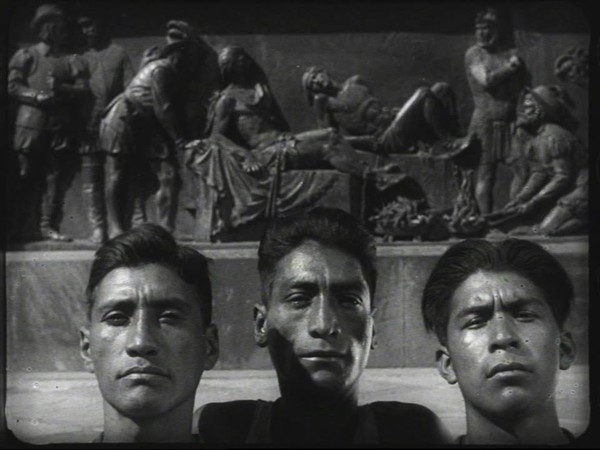Sergei Eisenstein: The Anthropology of Rhythm

Sergei Eisenstein: The Anthropology of Rhythm |
From 19 Settembre 2017 to 19 Gennaio 2018
Rome
Place: Nomas Foundation
Address: viale Somalia 33
Times: martedì - venerdì 14.30 - 19
Organizers:
- Con il patrocinio di Ambasciata della Federazione Russa nella Repubblica italiana
- Camera di Commercio Italo-Russa
- Fondazione Centro per lo sviluppo dei rapporti Italia-Russia
Telefono per informazioni: +39 06 86398381
E-Mail info: info@nomasfoundation.com
Official site: http://nomasfoundation.com/
Nomas Foundation is pleased to announce the opening of the exhibition "Sergei Eisenstein: The Anthropology of Rhythm" on September 19, 2017. Numerous documents from Eisenstein’s archives – The Russian State Archive of Literature and Arts (RGALI) and The National Film Foundation of Russian Federation (Gosfilmofond) – will be exhibited for the first time, including notebooks, drawings, film footage and photographs. Curated by art and film historians Marie Rebecchi (Paris) and Elena Vogman (Berlin), in collaboration with the artist and typographer Till Gathmann (Berlin), the exhibition will continue through January 19, 2018.
Rhythm is a medium of change; it constitutes a transition – from fear to joy, from ennui to awareness, from a simple movement to choreography or dance. The Soviet film director Sergei Eisenstein understood better than anyone that rhythm is necessary to enact transformation: as an anthropological means of organizing experience, rhythm becomes a vehicle of revolution.
The exhibition explores the intersecting aesthetic and political dimensions of the "anthropology of rhythm" in Eisenstein's unfinished film projects: "Que viva Mexico!" (1931–1932), "Bezhin Meadow" (1935–1937), and "Fergana Canal" (1939). Each of these film projects invents a new and unique cinematographic approach, yet they all share a common archaeological model of history and an anthropological construction of the gaze. By focusing on the representation of people, in particular the variety of ways in which Eisenstein filmed human faces, the materials presented in the exhibition illuminate hitherto unknown documentary and ethnographic facets of Eisenstein’s work.
A volume published by NERO, Rome, will accompany the exhibition. The book, designed by Till Gathmann, features essays by the curators, translations from Eisenstein’s unpublished diaries and further archival materials.
In connection with the exhibition, a symposium entitled "One hundred years after the October Revolution: the project and the forms of political cinema" [A cento anni dalla Rivoluzione d'Ottobre, il progetto e le forme di un cinema politico], organized by the Fondazione Archivio Audiovisivo del Movimento Operaio e Democratico (AAMOD) under the scientific direction of Pietro Montani, will take place at La Galleria Nazionale (Rome) on Monday, November 13.
Another symposium (curated by Giovanni Spagnoletti and Ermanno Taviani) will concern how Hollywood (and not only the American cinema) has dealt with the theme of the revolution and communism in a single country, in various cinematographic forms.
From November 20 to 27, a film program entitled "The Political Cinema in the USSR from 1924 to 1938" [Il cinema politico in URSS DAL 1924 AL 1938], will be on view at La Casa del Cinema (Rome). On this occasion a rare copy of "Eisenstein's Mexican Film: Episodes for Study" from the Museum of Modern Art (MoMA, New York), the footage edited by Jay Leyda, will be shown.
All these events are organized by: Fondazione AAMOD (Rome), Fondazione Gramsci (Rome), Goethe-Institut (Rome), NERO (Rome), Sapienza University of Rome, University of Rome Tor Vergata, Roma Tre University and Nomas Foundation (Rome).
In collaboration with: Bibliothek des Ibero-Amerikanischen Institutes (Berlin), Ethnologisches Museum, Staatliche Museen zu Berlin, Fondazione AAMOD (Rome), Fondazione Gramsci (Rome), Freie Universität (Berlin), Goethe-Institut (Rome), Gosfilmofond (Moscow), Les Documents Cinématographiques (Paris), NERO (Rome), RGALI (Moscow), Sapienza University of Rome, Staatsbibliothek zu Berlin, Preußischer Kulturbesitz (Berlin), University of Rome Tor Vergata, Roma Tre University.
Media partner: Diaphanes (Zurich)
SCARICA IL COMUNICATO IN PDF
COMMENTI

-
 Dal 31 gennaio 2024 al 04 maggio 2025
Fermo | Palazzo dei Priori
Dal 31 gennaio 2024 al 04 maggio 2025
Fermo | Palazzo dei Priori
-
 Dal 20 dicembre 2024 al 04 maggio 2025
Fermo | Palazzo dei Priori
Dal 20 dicembre 2024 al 04 maggio 2025
Fermo | Palazzo dei Priori
-
 Dal 20 dicembre 2024 al 04 maggio 2024
Gorizia | Palazzo Attems Petzenstein
Dal 20 dicembre 2024 al 04 maggio 2024
Gorizia | Palazzo Attems Petzenstein
-
 Dal 18 dicembre 2024 al 18 dicembre 2024
Venezia | Museo Correr
Dal 18 dicembre 2024 al 18 dicembre 2024
Venezia | Museo Correr
-
 Dal 14 dicembre 2024 al 02 marzo 2025
Palermo | Palazzo Abatellis
Dal 14 dicembre 2024 al 02 marzo 2025
Palermo | Palazzo Abatellis
-
 Dal 12 dicembre 2024 al 23 febbraio 2025
Roma | Palazzo Altemps
Dal 12 dicembre 2024 al 23 febbraio 2025
Roma | Palazzo Altemps


